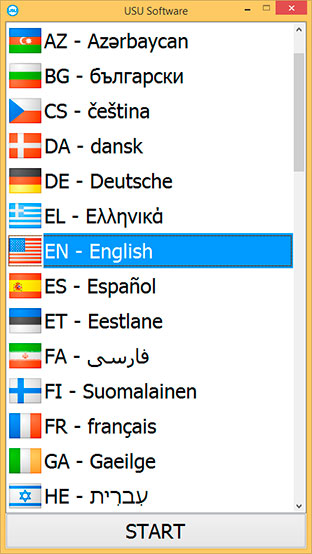Operating system: Windows, Android, macOS
Group of programs: Business automation
Accounting of stocks and expenses
- Copyright protects the unique methods of business automation that are used in our programs.

Copyright - We are a verified software publisher. This is displayed in the operating system when running our programs and demo-versions.

Verified publisher - We work with organizations around the world from small businesses to large ones. Our company is included in the international register of companies and has an electronic trust mark.

Sign of trust
Quick transition.
What do you want to do now?
If you want to get acquainted with the program, the fastest way is to first watch the full video, and then download the free demo version and work with it yourself. If necessary, request a presentation from technical support or read the instructions.

Contact us here
How to buy the program?
View a screenshot of the program
Watch a video about the program
Download the program with interactive training
Interactive instructions for the program and for the demo version
Compare configurations of the program
Calculate the cost of software
Calculate the cost of the cloud if you need a cloud server
Who is the developer?
Program screenshot

Accounting of stocks and expenses in the USU Software is organized in the present time mode - as soon as there have been modifications in warehouses or expenses have taken place, which regularly happens during the production process, this fact is instantly displayed in the number of stocks and volume worth. Automated control over stocks and expenses is the most stringent, automatic calculation is the most accurate, so an organization that uses a software configuration of stock and expenses accounting is always aware of what products are in stock and can plan of production worth in advance.
Stocks are defined as goods kept for sale in the common trade course, assets in such a sale trade, goods in the kind of raw materials and stockpiles to use in the production process, or the provision of services. Stock contains any items obtained and kept to resale, including goods obtained by a retailer and other tangible goods such as land and other real estates. Warehouses also include final items manufactured and work in progress, as well as raw materials and final materials intended to use in the production process. If essence is engaged in the provision of services, its inventories may be intangible.
Who is the developer?
2024-04-20
Video of accounting of stocks and expenses
This video can be viewed with subtitles in your own language.
The general principle established by the norm is that inventories should be determined at the lower of two values: historical and net realizable value. Net realizable value is the evaluated disposal price used in the common business path, less the evaluated value of production completion, and the evaluated value of realization. Clear value is the amount at which a product could be exchanged or a liability settled in a transaction between well-informed, independent sides willing to enter into such a transaction on a commercial foundation. Net realizable value is company-specific — this is the amount that the company expects to receive from the sale of a particular stock, but the clear expenses is not. Hence, the net realizable value may differ from fair value.
Cost is the exchange of monetary resources to something else that the enterprise can store and use. A company has bought goods, materials, spent money but did not lose it, because money turned into other resources. Not all desired expenses of the enterprise can be attributed to expenses. That is, not all expenses can be included in the financial result formula to calculate profit.
Download demo version
When starting the program, you can select the language.
Who is the translator?

Khoilo Roman
Chief programmer who took part in the translation of this software into different languages.

Instruction manual
Expenses accounting is a set of conscious actions aimed at reflecting the procedure of supply, production, and sale of goods occurring at the enterprise over a certain period through their quantitative measurement (in physical and value terms), registration, grouping, and analysis in sections that form the worth of finished items. If we consider the accounting of manufacturing as a process of reflecting the use of worth and results of past, present, and future production activities of the corresponding control model focused on fulfilling the primary goal of the enterprise, then such an accounting system will correspond to the main tasks of stocks control.
The main purpose of worth accounting is to control manufacturing activities and manage the value of their implementation. In expenses accounting, basic information is generated for the daily needs of the control apparatus. Therefore, it is he who occupies the central place in the management accounting system of the enterprise.
Order an accounting of stocks and expenses
To buy the program, just call or write to us. Our specialists will agree with you on the appropriate software configuration, prepare a contract and an invoice for payment.
How to buy the program?

The program will be installed
If the program is purchased for 1 user, it will take no more than 1 hourBuy a ready-made program
Also you can order custom software development
If you have special software requirements, order custom development. Then you won’t have to adapt to the program, but the program will be adjusted to your business processes!
Accounting of stocks and expenses
Accounting of the expenses of procurement of making stocks includes an accounting of all actual procurement expenses, including the search for quality raw materials or products, reliable suppliers, but transportation expenses of delivery to the warehouse are not included in the cost of procurement. As a rule, a separate department is engaged in the procurement of industrial stocks, which conducts its search and examination, collects reviews and recommendations, and achieves a loyal value. For this service to have an idea of the quality and relevance of inventories, in the software accounting configuration accounting of the costs of procurement of inventories, feedback is maintained with other structural divisions that use procured materials and raw materials in the manufacture or sell stocks in the form of finished products.
At the same time, the program accounting configuration of the expenses of procurement of stocks itself provides information on the demand and quality of materials and items, generating at the end of the period a report with an analysis of the present inventories demand and a report on all procurement costs, clearly showing their quantity in total expenses with differentiation by suppliers, commodity items. Based on such reporting, the stocks management apparatus can make a correct decision about the procurement procedure and the production stocks themselves - how much and when exactly procurement should be carried out, what the period of uninterrupted operation will be provided with the selected volume of materials and their expenses, how much production costs are expected in general.
The configuration costs accounting of inventories procurement forms several databases, through which quantitative and qualitative accounting is organized, while the indicators are changed automatically - based on the information that employees enter into their electronic journals after completing tasks within the framework of their production duties. The procurement accounting costs configuration independently selects and processes the necessary data, after which the work results are changed in the corresponding documents, including the volumes of materials and their costs. The change of indicators occurs automatically in all databases, directly or indirectly related to those indicators whose changes occurred in the course of activity. Moreover, the speed of data processing does not depend on the amount of information being processed and is fractions of a second, so they talk about keeping records in real-time, since the accounting procedures take negligible time, instantly providing the value that is actually at the time of the request.











